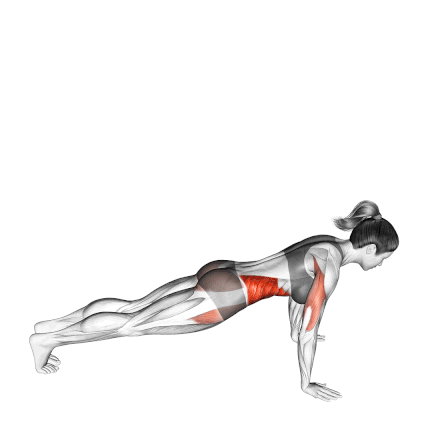A Push-Up with Rotation is a compound movement that combines the traditional push-up with a rotational twist of the torso at the top phase of the movement.
After pushing up, you rotate your body into a side plank, raising one arm toward the ceiling.
The push-up movement trains chest, triceps, and shoulders and the rotation phase engages your obliques (internal and external) as they work to both initiate the rotation and stabilize the torso.
Your deeper core muscles, like the transverse abdominis, work overtime to prevent unwanted spinal movement.
Know More: 20 Different Types Of Push Ups For Mass And Strength

Rotational Push Up Muscles Worked
- Primary Muscles: chest muscles (pectoralis major and minor), Triceps brachii, Anterior deltoids (front shoulders)
- Secondary Muscles: Obliques (internal and external), Rectus abdominis (abs), Latissimus dorsi (back) and Serratus anterior
- Stabilizing Muscles: Transverse abdominis, Erector spinae (lower back), Gluteus medius and minimus, Scapular stabilizers (traps, rhomboid) and Hip flexors
Know More: Push-Ups: How-To, Muscle Worked, Benefit, Variations
How To Do Push Up With Rotation

- Place hands slightly wider than shoulder width apart directly under your shoulders. Grip the floor with your fingers spread out wide.
- Feet should be hip-width apart (a slightly wider stance can provide more stability initially).
- Engage your core before you move. Imagine bracing for a light punch to the stomach. Squeeze your glutes. Your body should form a straight, rigid line from head to heels. No sagging hips or piking up.
- Inhale as you lower your chest towards the floor, keeping your elbows tracking slightly back (around 45 degrees from your body, not flared out wide).
- Exhale powerfully as you push the floor away, driving back up to the starting plank position.
- As you reach the top, begin shifting your weight onto one hand (let’s say the left hand).
- Pivot on the balls of your feet, allowing your hips and torso to rotate together. Don’t just twist from the lower back.
- Open your chest towards the side wall as you lift your right arm straight up towards the ceiling.
- Your body should form a “T” shape at the peak of the rotation. Your hips should stay lifted and aligned with your shoulder.
- Control the movement as you rotate back down. Bring your right hand back to the starting position under control.
- Perform the next push-up, then rotate to the opposite side (shifting weight onto the left hand, rotating right arm up). Alternate sides with each repetition for balanced development.
Tips And Techniques
- Engage your core, glutes, and quads throughout the movement to prevent sagging hips. Keep a neutral spine—don’t let your head drop or overextend the neck.
- Especially when you’re learning, widen your foot stance slightly (a bit more than hip-width). This creates a more stable base, making balancing during the rotation easier. As you get stronger, you can bring your feet closer together for a greater core challenge.
- Rotate through the thoracic spine (upper back), not the lower back. Pause briefly in the side plank to activate obliques and stabilizers.
- Elbows should be at a 45° angle to your torso—don’t flare them out. This protects the shoulder joint and engages the chest more effectively.
- Inhale as you lower into the push-up. Exhale as you push up and rotate.
- If you are new to this exercise, start with beginner-friendly modifications by doing Incline Rotational Push-Ups and Knee Rotational Push-Ups.
- And to make it more challenging, try to do Dumbbell Rotational Push-Up, Resistance Band Rotational Push-Up.

Manish is a NASM-certified fitness and nutrition coach with over 10 years of experience in weight lifting and fat loss fitness coaching. He specializes in gym-based training and has a lot of knowledge about exercise, lifting technique, biomechanics, and more.
Through “Fit Life Regime,” he generously shares the insights he’s gained over a decade in the field. His goal is to equip others with the knowledge to start their own fitness journey.
